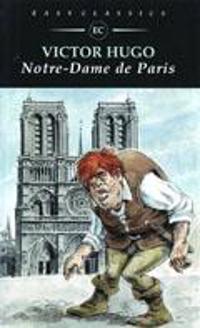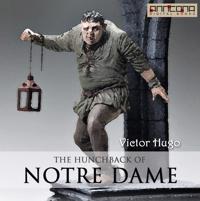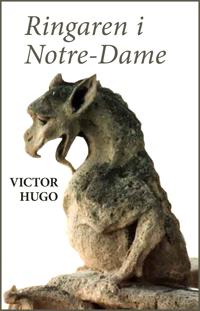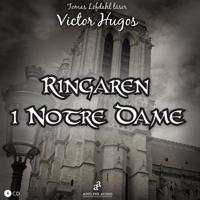Notre-Dame de Paris (D): Easy Classics (Häftad)
avVictor Hugo
ISBN: 9789121149379 - UTGIVEN: 199703Den klassiska berättelsen om ringaren i Notre Dame som blir förälskad i den vackra zigenerskan Esmeralda.
Om författarna
Berättelsen om den puckelryggige Quasimodo och den vackra Esmeralda.
[...]The Hunchback of Notre-Dame
avVictor Hugo
ISBN: 9789176051214 - UTGIVEN: 2014-03The Hunchback of Notre-Dame (French: Notre-Dame de Paris) is a French Gothic novel by Victor Hugo published in January 14, 1831. The title refers to the Notre Dame Cathedral in Paris, on which the story is centered.
The novel's original French title, Notre-Dame de Paris (the formal title of t[...]Les Misérables (e-bok)
avVictor Hugo
ISBN: 9789176051238Les Misérables is a French historical novel by Victor Hugo, first published in 1862, that is considered one of the greatest novels of the 19th century. Beginning in 1815 and culminating in the 1832 June Rebellion in Paris, the novel follows the lives and interactions of several characters, focusing[...]
Ringaren i Notre-Dame (e-bok)
avVictor Hugo
ISBN: 9789185201228 - UTGIVEN: 201111I ett myllrande medeltida Paris utspelar sig Victor Hugos klassiska roman om den missbildade och döve ringaren Quasimodo som förälskar sig i den undersköna zigenarflickan Esmeralda.[...]
Ringaren i Notre Dame (CD-bok)
avVictor Hugo
ISBN: 9789186519452 - UTGIVEN: 201101En vacker söndagsmorgon hade någon lagt en varelse på bänken utanför kyrkan. Där brukade man lägga hittebarn för att de skulle bli omhändertagna av fattigvården. Det som nu låg där hade lockat en samling nyfikna till sig. Och anledningen var att det inte var något nyfött barn utan ett [...]
Ringaren i Notre Dame (Nedladdningsbar MP3)
avTomas Löfdahl, Victor Hugo
ISBN: 9789186519810 - UTGIVEN: 201301En vacker söndagsmorgon hade någon lagt en varelse på bänken utanför kyrkan.Där brukade man lägga hittebarn för att de skulle bli omhändertagna av fattigvården.Det som nu låg där hade lockat en samling nyfikna till sig. Och anledningen var attdet inte var något nyfött barn utan ett mis[...]
Att sticka ut - Victor Hugo Wickström (Inbunden)
avKjell Albin Abrahamson
ISBN: 9789198181067 - UTGIVEN: 2015-10-01Victor Hugo Wickström
ISBN: 9789198181098 - UTGIVEN: 2015-11Detta är berättelsen om Victor Hugo Wickström (18561907) skomakarsonen från Hedemora som blev en av sin tids märkligaste kulturpersonligheter. I sin samtid stack han ut men är i dag lika bortglömd som en Nobelpristagare. Som stridbar chefredaktör för Jämtlandsposten och kontroversiell för[...]
Kurjat (Pocket)
avVictor Hugo
ISBN: 9789510396971 - UTGIVEN: 2013Vallankumouksellisessa maineessa olleen kirjailijan Victor Hugo (1802-1885) kuuluisin teos Kurjat ilmestyi vuonna 1862. Sillä oli poikkeuksellinen vaikutus koko silloisen Ranskan omaantuntoon, ja se menestyi heti myös muualla Euroopassa. Upean kaunokirjallisen tarinan lisäksi Hugo oli kirjoittanu[...]
Notre-Dame de Paris (Dodo Press) (Pocket)
avHugo, Victor
ISBN: 9781406568981Victor-Marie Hugo (1802-1885) was a French poet, playwright, novelist, essayist, visual artist, statesman, human rights campaigner, and perhaps the most influential exponent of the Romantic movement in France. In France, Hugo's literary reputation rests primarily on his poetic and dramatic output an[...]
Frankenstein Meets the Hunchback of Notre-Dame (Pocket)
avNodier, Charles, Hugo, Victor
ISBN: 9781932983388A rare 1826 French play by master fantasist Charles Nodier revisits the legend of Frankenstein, recasting the legendary scientist as a sorcerer and his Monster as a mute killer from Hell. The Hunchback of Notre-Dame was adapted and rewritten by Victor Hugo himself into a stage play that throws new l[...]
The Man Who Laughs (Pocket)
avHugo, Victor
ISBN: 9781934169001Victor-Marie Hugo (1802-1885) wrote L'Homme Qui Rit (The Man Who Laughs) in 1869. One of the greatest French novelists, poets, playwrights and socio-political figures of his time, he is probably best known for having written Notre-Dame de Paris (The Hunchback of Notre Dame) (1831) and Les Misrables [...]
The Man Who Laughs (Inbunden)
avHugo, Victor
ISBN: 9781934169018Victor-Marie Hugo (1802-1885) wrote "L'Homme Qui Rit" ("The Man Who Laughs") in 1869. One of the greatest French novelists, poets, playwrights and socio-political figures of his time, he is probably best known for having written "Notre-Dame de Paris" ("The Hunchback of Notre Dame") (1831) and "Les M[...]
Ringaren i Notre-Dame (Kartonnage)
avHugo, Victor, Bylock, Maj
ISBN: 9789129652727 - UTGIVEN: 2000-09-12Quasimodo, den vanskapte ringaren i Notre-Dame, med sitt enda öga och sina otäcka vårtor, blir förälskad i den vackra Esmeralda. Hon sägs vara ett hittebarn som tagits om hand av zigenarna. Esmeralda blir anklagad för häxeri och mord och dömd till döden. Men Quasimodo försöker rädda hen[...]


















